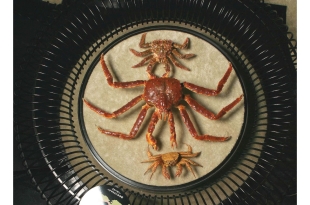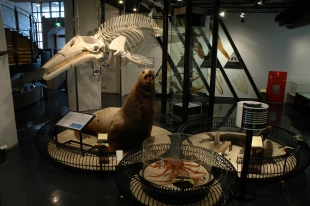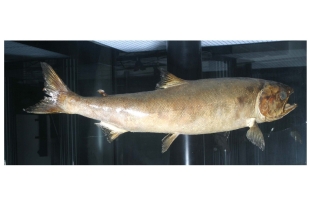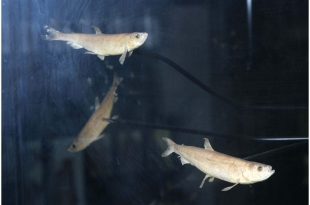1-20~27 Sea of Kushiro 1
1-20 Crab Species
The crab is one of the most iconic marine animals of Hokkaido, and a lucrative catch for fishermen. As Kushiro is the largest fishing port on Hokkaido’s east coast, it receives crab catches from the North Pacific, the Sea of Okhotsk, and the Bering Sea, as well as the waters along the coast of eastern Hokkaido.
The red king crab (Paralithodes camtschaticus), also known as the Alaskan king crab, is a valuable winter catch. It is one of the largest crabs in the world, with a shell measuring up to 25 centimeters and legs that can reach almost 1 meter long. Red king crabs and Hanasaki crabs (spiny king crabs; Paralithodes brevipes), like all king crab species, have eight legs, including their claws. King crabs are not considered true crabs (which have ten legs); they are more closely related to hermit crabs. The Hanasaki crab is named for the town of Hanasaki on the Nemuro Peninsula east of Kushiro, where they are caught.
The horsehair crab (Erimacrus isenbeckii), which is caught in the seas off the coast of Kushiro and Nemuro in autumn, has ten legs, marking it as a true crab. Its name derives from the hairlike soft spines that cover its shell.

1-21 Marine Mammals Around Kushiro
The seas around Kushiro support many marine mammals, most notably whales, seals, and Steller sea lions (Eumetopias jubatus). Common seals (Phoca vitulina), also known as harbor seals, live in eastern Hokkaido year-round and breed in rocky coastal areas, where they are sheltered from the weather and predators. Spotted seals (Phoca largha) breed on ice floes and arrive in Hokkaido in summer on drift ice from the Sea of Okhotsk.
Steller sea lions migrate from the Sea of Okhotsk to Hokkaido in winter. They live in subarctic waters, breeding and resting on beaches and rocky reefs, and feed on a wide range of fish including Alaska pollock, mackerel, herring, and Pacific cod. At one time, Steller sea lions were endangered, due in part to illegal hunting and loss of habitat, but their numbers have increased in recent years.

1-22 Salmon Species
Hokkaido is world-famous for its salmon. Three types of salmon are commonly found around Kushiro: chum salmon (Oncorhynchus keta), pink salmon (O. gorbuscha), and masu salmon (O. masou).
Chum salmon, the predominant salmon species in the seas around Kushiro, is best known for its large orange roe. After chum salmon migrate and mature in the Sea of Okhotsk, the North Pacific, and the Bering Sea for around four years, they return to their home grounds to spawn once before they die. More than 100,000 salmon migrate up the Kushiro River between September and December each year. Since 1876, breeding programs have helped maintain a healthy population.
Pink salmon, the most abundant species of salmon in the world, inhabit the Pacific Ocean and the Sea of Okhotsk. In Hokkaido, pink salmon spawn in rivers along the east coast from Kushiro to Shiretoko. During the spawning season, the males develop a humped back and larger teeth to help them fight off rival males as they battle to fertilize eggs released by the females.
Masu salmon live half their lives in rivers and half in the ocean, then return to their home river to spawn before dying. They have a limited range, staying in coastal waters off northern Japan after reaching maturity.

1-23 Masu Salmon
Masu salmon (Oncorhynchus masou), also called cherry salmon, live half their life in a river as freshwater fish before migrating to the ocean. They return to their home river to spawn after two to three years at sea. In Japanese, they are called sakura masu (cherry salmon) because they turn pink (the color of cherry blossoms) on reaching maturity, and because they are usually caught during spring (cherry-blossom season), when they return to their river spawning grounds. Some masu salmon never leave their home river; these fish are called yamame (yamabe in Hokkaido). Masu salmon have a very limited range, staying in coastal waters off northern Japan after reaching maturity.
1-24 Marine Life on the Rocky Shores
A deep underwater canyon divides Kushiro Bay into two distinct environments, each supporting different marine life. The west side has a gentle, sandy shoreline, while the east side has steep, rocky cliffs that stretch around the coast to Nemuro. A number of factors contribute to the biological richness of the rocky side. The rocks provide platforms for kelp and shelter for crustaceans, whelks, and small fish. Furthermore, warm and cold currents meet here, bringing zooplankton and phytoplankton to the area. These conditions attract migratory fish such as sardines, creating fertile fishing grounds.
Adapting to the environment
Some fish, like the rock greenling (Hexagrammos lagocephalus) and the whitespotted greenling (Hexagrammos stelleri), have developed the ability to change color to camouflage themselves against rocks. Others, including the great sculpin (Myoxocephalus polyacanthocephalus) and the Gilbert’s Irish lord (Hemilepidotus gilberti), have spiny bodies and fins that protect them from larger predators and help them anchor themselves among rocks.
1-25 Marine Life on the Sandy Shores
The west side of Kushiro Bay has a smooth, sandy shore and sea bed, with few places for fish to hide. The features and survival techniques of the fish that inhabit this side of the bay are different than those of the fish on the rocky east side.
Natural camouflage
These sandy areas support many species of flatfish, such as the starry flounder (Platichthys stellatus), cresthead flounder (Limanda schrenki), and mottled skate (Raja pulchra). These species have flat bodies and colors that match the sandy sea bed. Thin-bodied fish such as Pacific rainbow smelt (Osmerus mordax dentex) and Japanese smelt (Hypomesus japonicus) are silvery and inconspicuous against the sand. The soft, sandy bed is the ideal environment for mollusks such as the giant Ezo scallop (Patinopecten yessoensis) and the Japanese surf clam (Pseudocardium sachalinense), the latter of which can burrow under the sand to evade predators.
1-26 Alaska pollock
The Alaska pollock (Theragra chalcogramma, suketodara in Japanese) is the mainstay of Kushiro’s fishing industry. It is genetically similar to cod, and its principal habitats are the waters of the North Pacific, including the Sea of Okhotsk and the waters around Hokkaido. From winter to spring, schools of this cold-water fish migrate to Funkawan Bay near Hakodate in southwestern Hokkaido to spawn before feeding in the waters of Kushiro from summer to autumn.
The roe of the Alaska pollock is highly prized. The egg sacs are salted and sold as tarako or mentaiko, a popular topping for rice and pasta. The flesh of the fish is usually minced and processed to make kamaboko (fish cake) and fish sausage.
1-27 Shishamo: The Willow-Leaf Fish
Shishamo (Spirinchus lanceolatus), a type of smelt, is found along Hokkaido’s Pacific coast. Its name is derived from the Ainu words susu ham or shushu hamo, meaning “willow-leaf fish,” as it is similar in size and shape to a willow leaf.
Shishamo are anadromous, meaning that they migrate from the sea to freshwater to spawn. From mid-October to early December, shishamo in the Kushiro region migrate upstream to spawn in the Shin-Kushiro, Akan, Shoro, and Charo Rivers. They are a prized food source in Japan, usually grilled whole. Fishing is limited to the spawning season.

This English-language text was created by the Japan Tourism Agency.
このページに関するお問い合わせ
生涯学習部 博物館 博物館担当
〒085-0822 北海道釧路市春湖台1番7号 博物館
電話:0154-41-5809 ファクス:0154-42-6000
お問い合わせは専用フォームをご利用ください。
